Is this a new(er) code? I have worked in countless facilities with 1p breakers providing 120v from 3 phase panels.In the US most of the original three phase wiring is 3 hot legs with no neutral as time has passed the newer installations have included neutral and grounds from the feeder transformer.
It is not an accepted practice to have three phase and single phase mixed in one panel.
This comes back to having no neutral connection and the ground absolutely shall never be used as a neutral.
This starts the argument that they are bonded together in the box so it's the same...until a failure causes the ground to become hot or a poor connection fails to return it to the box.
-
Welcome back Guest! Did you know you can mentor other members here at H-M? If not, please check out our Relaunch of Hobby Machinist Mentoring Program!
You are using an out of date browser. It may not display this or other websites correctly.
You should upgrade or use an alternative browser.
You should upgrade or use an alternative browser.
Beauty in The Beast: Webb 5BVK Barn Find/Conversion
- Thread starter Charlieman22
- Start date
- Joined
- Nov 14, 2020
- Messages
- 1,739
In the U.S. there were factories that would pull a single phase out of a three phase panel, but those aren't that common in my area "Ohio" but don't let that fool you before adoption of the NEC all kinds of things were done and in plants that I worked we were responsible for making it correct but not necessarily up to code.. if the plant is old enough it could be very difficult and expensive to truly bring it to code.....so much has been "grandfathered in" depending what the building was used for and the era it was built in you can find all kinds of circumstances.
newer installations are generally much safer.
As for when a nec code changed? Start researching the info is out there but it might take a little effort to find.
If your panel will support three phase and has a neutral then it's all about the regulations whether you are allowed to or not. But using one leg and using a ground as the neutral is dangerous and forbidden by code.
Talk to your local electrical inspector he has the right to say no even if it is in the NEC code, local regs can be stiffer and its up to him.
newer installations are generally much safer.
As for when a nec code changed? Start researching the info is out there but it might take a little effort to find.
I am reasonably sure there was a neutral provided in the panel you have spoken about. Look inside your panel door there is a wealth of information there.Is this a new(er) code? I have worked in countless facilities with 1p breakers providing 120v from 3 phase panels.
If your panel will support three phase and has a neutral then it's all about the regulations whether you are allowed to or not. But using one leg and using a ground as the neutral is dangerous and forbidden by code.
Talk to your local electrical inspector he has the right to say no even if it is in the NEC code, local regs can be stiffer and its up to him.
Last edited:
Every place I'm referring to did have a neutral run to the panel. That being said, why can't the OP pull a neutral and create a 60 amp sub panel? 3p to the mill and 1p for everything else? The key thing to keep in mind, in commercial panels they assume everything WILL be running at the same time. This means the total amperage of breakers can't exceed the capacity of the feeder, 60a doesn't leave much.
- Joined
- Nov 14, 2020
- Messages
- 1,739
I feel my part of this conversation coming to an end.
There was a time that people felt they could wire as they wished and they did.
Fortunately that has for the most part changed.
There is a large book called the NEC it has been developing for decades it includes every portion of this discussion from what is acceptable work standards to materials, environmental concerns and exceptions.
I personally don't know California code buy I have heard it to be more stringent.
There was a time that people felt they could wire as they wished and they did.
Fortunately that has for the most part changed.
There is a large book called the NEC it has been developing for decades it includes every portion of this discussion from what is acceptable work standards to materials, environmental concerns and exceptions.
I personally don't know California code buy I have heard it to be more stringent.
- Joined
- Nov 14, 2020
- Messages
- 1,739
The problem is you can't just post a code,
Even when guys spout what gauge wire to run it depends on other factors ambient air temperature, type of wire, length of run, other conductors in the conduit.
For the average guy or even low level maintenance technicians your safest and best route is to run a dedicated circuit in its own conduit with the calculations done for length of run, ampacity and properly sized circuit breaker...you don't have to be a wizard, search out the NEC code you can gain free access online.
Remember this is a great reference but it's important to read ALL revalent sections.
CAN YOU JUST "XXXX" technically it might work but the electrical system is safe when YOU work to code.
Even when guys spout what gauge wire to run it depends on other factors ambient air temperature, type of wire, length of run, other conductors in the conduit.
For the average guy or even low level maintenance technicians your safest and best route is to run a dedicated circuit in its own conduit with the calculations done for length of run, ampacity and properly sized circuit breaker...you don't have to be a wizard, search out the NEC code you can gain free access online.
Remember this is a great reference but it's important to read ALL revalent sections.
CAN YOU JUST "XXXX" technically it might work but the electrical system is safe when YOU work to code.
- Joined
- May 2, 2021
- Messages
- 330
So after some interesting discussions here, I set about trying to rectify my electrical supply issues.
I did some further research on 208 3P and 110 1P in the same box.
Had a look at the neighboring shops - that had been professionally upgraded.
Had a chance to speak to a local electrician.
Reached out to a few online forums.
What I learned was, 1p and 3P in the same box is fully acceptable under the California version of the NEC, and very common.
The caveat being, your "load center" - aka breaker box - needs to be listed to have both in it.
Here is a diagram of how it is to be wired:
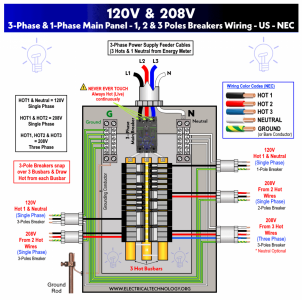
With this knowledge in hand, I decided that my best option was to replace the existing box with a new, larger, higher amp one.
I opted for a 18 place, 36 circuit, version - largely because it was available at the local supply shop and very reasonable in cost ($300).
This is the first time I have ever replaced a box, much less a 3P one, so I watched some YouTube and followed good practice.
- The box is proceeded by a shut off.
- I used anti corrosion grease on all my large incoming power/neutral/ground lines.
- Code calls for red/blk/blu - which I maintained. On existing areas I needed to utilize, I used colored tape to mark the lines as per code.
- On my 208V 1P, where the electrician ran some of the grounds to ground, and some to neutral - I rewired to be all to ground.
Editors note: turns out that in a 208 1P, if you run ground to neutral, you risk electrifying the "ground" wire if you have a fault where a hot touches the metal casing of your machine. = bad.
After testing to ensure nothing was live - I tackled the birds nest of an old box that existed.
All out of space/ grounds going to neutral/...
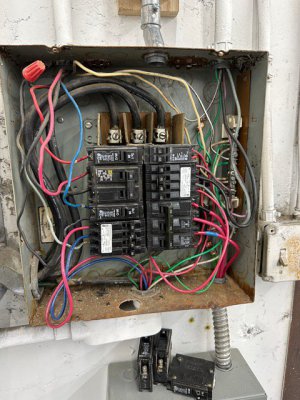
Tidied up a bit, room for 3 @ 3 phase breakers to allow individualized circuits for each of the big machines.
A bit of capacity should I need to expand - though not much.
White 6AWG marked with blue tape at both ends to signify blue wire.
All legs tested within 1 volt of ea. other (214V) from leg to leg.
123V from leg to ground.
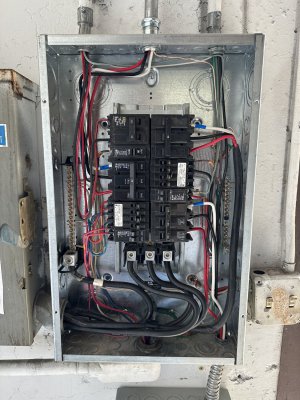
Time to turn my attention to the mill.
I did some further research on 208 3P and 110 1P in the same box.
Had a look at the neighboring shops - that had been professionally upgraded.
Had a chance to speak to a local electrician.
Reached out to a few online forums.
What I learned was, 1p and 3P in the same box is fully acceptable under the California version of the NEC, and very common.
The caveat being, your "load center" - aka breaker box - needs to be listed to have both in it.
Here is a diagram of how it is to be wired:

With this knowledge in hand, I decided that my best option was to replace the existing box with a new, larger, higher amp one.
I opted for a 18 place, 36 circuit, version - largely because it was available at the local supply shop and very reasonable in cost ($300).
This is the first time I have ever replaced a box, much less a 3P one, so I watched some YouTube and followed good practice.
- The box is proceeded by a shut off.
- I used anti corrosion grease on all my large incoming power/neutral/ground lines.
- Code calls for red/blk/blu - which I maintained. On existing areas I needed to utilize, I used colored tape to mark the lines as per code.
- On my 208V 1P, where the electrician ran some of the grounds to ground, and some to neutral - I rewired to be all to ground.
Editors note: turns out that in a 208 1P, if you run ground to neutral, you risk electrifying the "ground" wire if you have a fault where a hot touches the metal casing of your machine. = bad.
After testing to ensure nothing was live - I tackled the birds nest of an old box that existed.
All out of space/ grounds going to neutral/...

Tidied up a bit, room for 3 @ 3 phase breakers to allow individualized circuits for each of the big machines.
A bit of capacity should I need to expand - though not much.
White 6AWG marked with blue tape at both ends to signify blue wire.
All legs tested within 1 volt of ea. other (214V) from leg to leg.
123V from leg to ground.

Time to turn my attention to the mill.
- Joined
- May 2, 2021
- Messages
- 330
Thanks guys.
Somehow managed to get halfway through my 50's and not really understand how A/C electricity worked.
Replacing a 3P/1P breaker panel was a good learning experience.
Maybe I should build a house.

But before I get there - time to get moving on the CNC conversion.
I tore into the old electronics to get it powered up, and Jim deciphered the manual for the drives (link on prior page).
There was a contractor (nice, Allen Bradley) that powered up the transformer - which in turn powered some SCR's which power the drives.
Transformer has jumper wires, that once set up properly outputs about 165VAC.
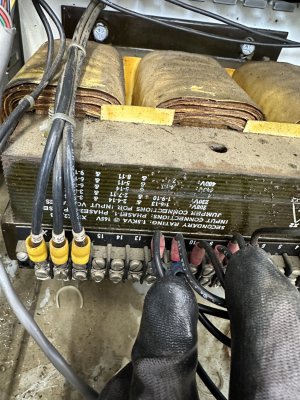
With power flowing to the drive boards (there are three), Jim sorted out what need to have jumpers on it, and where we would add 1VDC to activate any given axis.
We couldn't get it to work properly at first - but using the trouble shooting info from the manual, Jim identified the critical additional jumpers.
On these Siemens boards, 9 puts out ~20V and needed to be jumpers to 64 on one b board and 65 on the other, then 14 and 56 needed the 1V used in the correct polarity.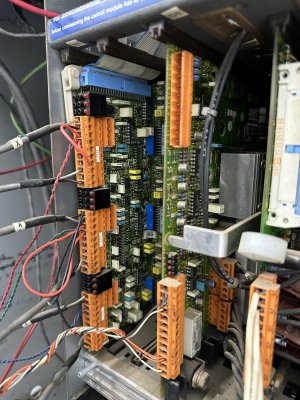 And when I did this, the table zipped along so smoothly and cyberneticly; it was awesome!
And when I did this, the table zipped along so smoothly and cyberneticly; it was awesome!
Swoosh.
The box was, well, a birds nest.
Felt like I was back at the breaker panel.
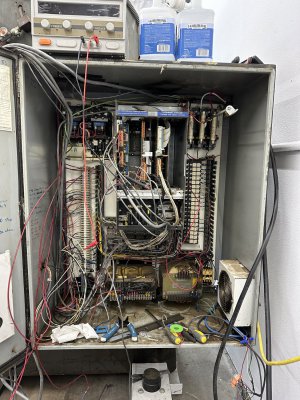
From here, I started ripping out everything we wouldn't need.
Reversing contractors came out.
A few handfuls of relays.
A transformer.
And a whole bunch of cable.
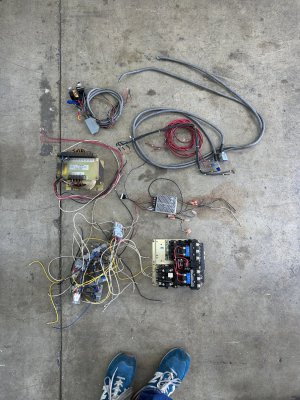
Which left me with a bunch more room.
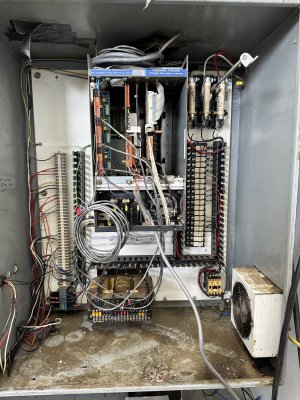
It's still criminally dirty in there - but there is space for me to shuffle things around.
I will get it cleaned up and start mounting components tomorrow, while Jim works on the wiring diagram.
I plan to consolidate some of the existing components to open up some space on the panel and leave a better arrangement.
More to come...
-CM
Somehow managed to get halfway through my 50's and not really understand how A/C electricity worked.
Replacing a 3P/1P breaker panel was a good learning experience.
Maybe I should build a house.
But before I get there - time to get moving on the CNC conversion.
I tore into the old electronics to get it powered up, and Jim deciphered the manual for the drives (link on prior page).
There was a contractor (nice, Allen Bradley) that powered up the transformer - which in turn powered some SCR's which power the drives.
Transformer has jumper wires, that once set up properly outputs about 165VAC.

With power flowing to the drive boards (there are three), Jim sorted out what need to have jumpers on it, and where we would add 1VDC to activate any given axis.
We couldn't get it to work properly at first - but using the trouble shooting info from the manual, Jim identified the critical additional jumpers.
On these Siemens boards, 9 puts out ~20V and needed to be jumpers to 64 on one b board and 65 on the other, then 14 and 56 needed the 1V used in the correct polarity.
 And when I did this, the table zipped along so smoothly and cyberneticly; it was awesome!
And when I did this, the table zipped along so smoothly and cyberneticly; it was awesome!Swoosh.
The box was, well, a birds nest.
Felt like I was back at the breaker panel.

From here, I started ripping out everything we wouldn't need.
Reversing contractors came out.
A few handfuls of relays.
A transformer.
And a whole bunch of cable.

Which left me with a bunch more room.

It's still criminally dirty in there - but there is space for me to shuffle things around.
I will get it cleaned up and start mounting components tomorrow, while Jim works on the wiring diagram.
I plan to consolidate some of the existing components to open up some space on the panel and leave a better arrangement.
More to come...
-CM
- Joined
- May 2, 2021
- Messages
- 330
Idle hands - idle minds.
What ever the saying is.
Decided that I would clear off the stuff inside the cabinet while Jim creates the wiring diagram.
When I was done - felt like I should give it a good internal cleaning.
Closer examination - realized the back panel comes out - so you can do your layout flat and then re-install.
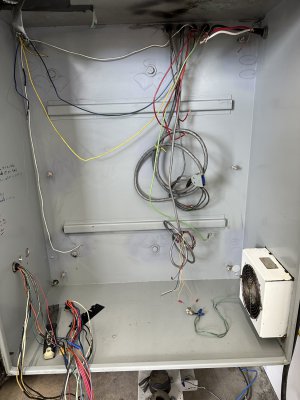
Then I laid out the panel on the floor - and began taking things off it so I could think about where I wanted to put them all in the end.
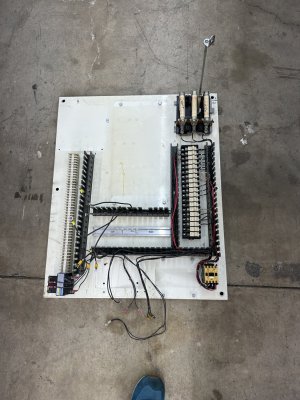
And then I looked at the machine and thought: you know - I have always hated that box mounted to the side of the machine.
I have to walk around the door to open it, it blocks light, and to be honest - I just hate the way it looks.
The machine is casted with Art Deco curves, painted in (admittedly ugly) green, and the box is this rectangle of hard corners with no effort at all to match the color (painted blackish).
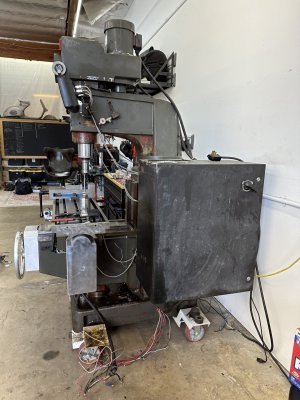
And then I got out my scraper and some degreaser and cleaned up the side of the machine after removing the box (balanced on a car jack).
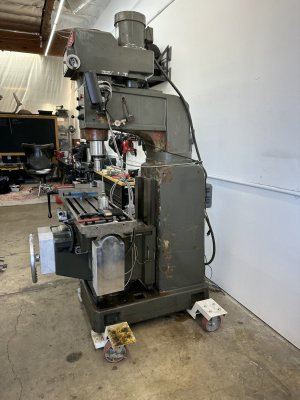
My plan is to mount the box to the wall - so that the door swings out - and it can sit above an existing tool cart - the net effect of which, will be less overall wall space used.
Need to find some cool and functional conduit. I like the chrome that my DRO uses. I also kinda like the black.
Existing conduit will be replaced - it is stiff and cracked in many places.
Welcome any ideas or links if y'all have some sources or inspirational pics you want to share of a nice looking machine/conduit.
Thanks and good weekend.
-CM
What ever the saying is.
Decided that I would clear off the stuff inside the cabinet while Jim creates the wiring diagram.
When I was done - felt like I should give it a good internal cleaning.
Closer examination - realized the back panel comes out - so you can do your layout flat and then re-install.

Then I laid out the panel on the floor - and began taking things off it so I could think about where I wanted to put them all in the end.

And then I looked at the machine and thought: you know - I have always hated that box mounted to the side of the machine.
I have to walk around the door to open it, it blocks light, and to be honest - I just hate the way it looks.
The machine is casted with Art Deco curves, painted in (admittedly ugly) green, and the box is this rectangle of hard corners with no effort at all to match the color (painted blackish).

And then I got out my scraper and some degreaser and cleaned up the side of the machine after removing the box (balanced on a car jack).

My plan is to mount the box to the wall - so that the door swings out - and it can sit above an existing tool cart - the net effect of which, will be less overall wall space used.
Need to find some cool and functional conduit. I like the chrome that my DRO uses. I also kinda like the black.
Existing conduit will be replaced - it is stiff and cracked in many places.
Welcome any ideas or links if y'all have some sources or inspirational pics you want to share of a nice looking machine/conduit.
Thanks and good weekend.
-CM

